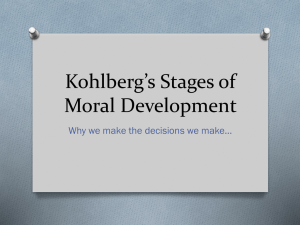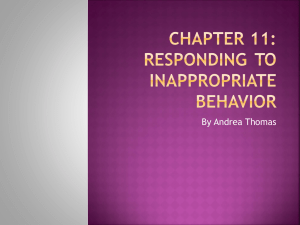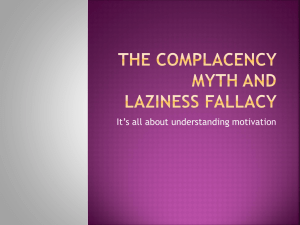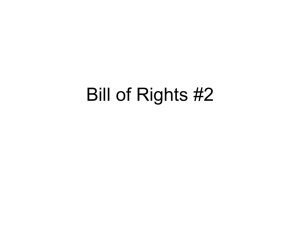Understanding and managing challenging behaviors
advertisement
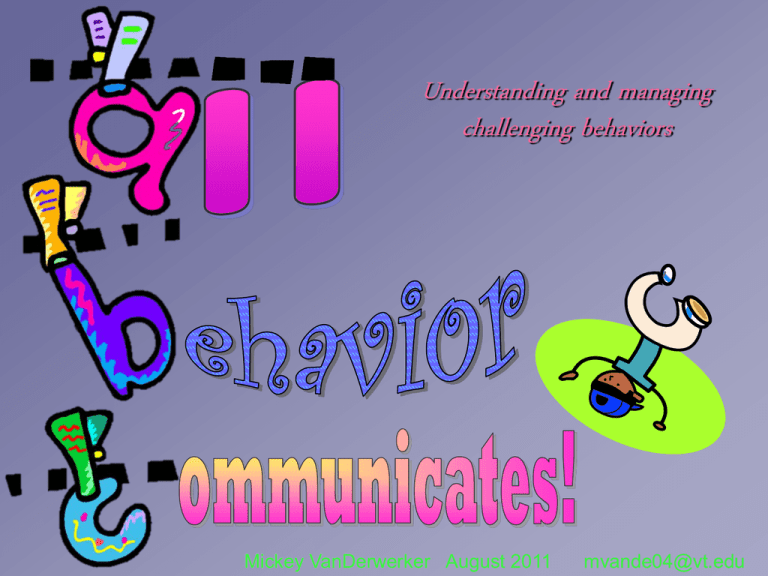
Understanding and managing challenging behaviors Mickey VanDerwerker August 2011 mvande04@vt.edu Where we start All behavior communicates Behavior is taught and learned We bring our own issues into the behavior dance Group strategies before individual strategies Developmental levels, diagnosis and temperament matter All behavior communicates. All behavior communicates. We don’t have to “like” how the message is being sent. Our behavior communicates too. Behavior is taught and learned. We bring our own issues to the behavior dance. What behaviors push your “hot” buttons? Family issues first. Are their other family behaviors that need to be addressed? Relationships matter the most! Developmental levels, diagnosis and temperament matter After a hasty special education placement for behavior problems, school officials were embarrassed to learn that Marty really did have ants in his pants. Temperament website and book What will work for your family? Is this idea reasonable for my child? Temperament Developmental needs Diagnosis Is this idea reasonable for me? Temperament Your experience Ways to overcome your issues Identify the behavior(s). Determine why they are happening (the message). Environmental supports Teaching replacement behaviors that work Reacting in ways that make things better Making sure that your plan is working Say what the behavior looks like, not what you think it means. Irritable aggressive upset non-compliant rubbing his face hits the adult’s arm pulling his hair doesn’t look when his name is called Aggression Tantrum Noncompliance Hitting Threatening Scratching Pinching Kicking Biting Throwing things Screaming Crying Whining Cussing Refuses to respond to a request Passive when a request Social Withdrawal Self injury/ Repetitive Behaviors Others? Primarily plays alone Doesn’t respond to peers attempts to play Scratching self Biting self Hitting self Rocking back & forth Spinning objects is made Determining the message behind the behaviors Pay attention to me Look at me, I’m silly Play with me I want _____ I don’t want to do this anymore I don’t understand Stop More messages I want out Help me; I’m frustrated You used to give it to me; I want it now I’m not getting the input I need I’m bored I’m tense, anxious, nervous, excited, overwhelmed I’m hurt, sick, tired Who what when where why What: define the behavior Why: identify the message When, where and who: recognize patterns Who: which of you needs to make changes? Setting up the environment to support behaviors you want to encourage and prevent behaviors you want to avoid. High rates of positive interactions Appropriate expectations Keeping busy Supervision and support Balanced daily schedule Setting limits clearly Facilitate transitions Space and room arrangements Structure and routines This is a sample of environmental supports. Supervision and support Man-to-man or zone defense? What do the other adults in the house need to know and do? Teaching replacement behaviors These have to be as “easy” as the original behavior. They have to work as effectively. Learning new behaviors takes time. Skill deficit Performance deficit Teaching new behaviors Use your words, gestures, eyes, fingers, pictures Develop higher level skills Coping and self-management Teaching the routines and the rules of the room Rewarding approximations Scripted stories and dramatic play First-Then Visual First Lentini, R., Vaughn, B. J., & Fox, L. (2005). Teaching Tools for Young Children with Challenging Behavior. Tampa, Florida: University of South Florida, Early Intervention Positive Behavior Support. Then Using multiple strategies to support appropriate behavior Reacting in ways that help The goal is not “to punish.” The goal is to move on. Consequences can be used fairly and reasonably: The child must have the ability to avoid the consequences The child must know that the consequence exists The powerful behavior changers are environmental supports and teaching new behaviors Effects of punishment Punishment suppresses behavior but doesn’t eliminate it Punishment suppresses only in the presence of the punisher Punishment teaches children to associate punishment with the punisher and not with their behavior Punishment produces emotional side effects which lowers children’s self-esteem Punishment does not guide the child to appropriate behavior Punishment produces aggression in children Punishment can increase a child’s desire to persist in a behavior (a power struggle) Punishment does not help kids learn self-discipline Punishment models “power-assertive” ways to solve problems Planning your response Predict and prevent Ignore but respond Distraction/redirection Offer a substitute Change your automatic responses Change the scene Presenting feedback Contingent instruction Time-away Active listening Strategic capitulation Crisis management plans Predict and prevent See it coming? What can you do to prevent it or to minimize it? Behavior is not learned overnight. It won’t change overnight. Extra information Setting up the environment to support behaviors you want to encourage and prevent behaviors you want to avoid. High rates of positive interactions Appropriate expectations Keeping busy Supervision and support Balanced daily schedule Setting limits clearly This is a sample of environmental supports. High rates of positive interactions Pennies in your pocket Doesn’t have to be “I like the way…” Talking in front of kids Appropriate expectations Developmental levels, temperament, diagnosis Helping kids by counter-regulating and counter-balancing emotional reactions You can keep them busy or… Not too easy/not too hard Supervision and support Man-to-man or zone defense? What do the other adults in the house need to know and do? Balanced daily schedule Setting limits clearly Consistency Practice Consistency Teaching replacement behaviors These have to be as “easy” as the original behavior. They have to work as effectively. Learning new behaviors takes time. Skill deficit Performance deficit Teaching new behaviors Use your words, gestures, eyes, fingers, pictures Develop higher level skills Coping and self-management Teaching the routines and the rules of the room Rewarding approximations Scripted stories and dramatic play Using multiple strategies to support appropriate behavior Circle “First-Then” Mini Schedule Lentini, R., Vaughn, B. J., & Fox, L. (2005). Teaching Tools for Young Children with Challenging Behavior. Tampa, Florida: University of South Florida, Early Intervention Positive Behavior Support. Visual Choice Board Lentini, R., Vaughn, B. J., & Fox, L. (2005). Teaching Tools for Young Children with Challenging Behavior. Tampa, Florida: University of South Florida, Early Intervention Positive Behavior Support. The Chocolate Covered Cookie Tantrum Reacting in ways that help The goal is not “to punish.” The goal is to move on. Consequences can be used fairly and reasonably: The child must have the ability to avoid the consequences The child must know that the consequence exists The powerful behavior changers are environmental supports and teaching new behaviors Effects of punishment Punishment suppresses behavior but doesn’t eliminate it Punishment suppresses only in the presence of the punisher Punishment teaches children to associate punishment with the punisher and not with their behavior Punishment produces emotional side effects which lowers children’s self-esteem Punishment does not guide the child to appropriate behavior Punishment produces aggression in children Punishment can increase a child’s desire to persist in a behavior (a power struggle) Punishment does not help kids learn self-discipline Punishment models “power-assertive” ways to solve problems Planning your response Predict and prevent Ignore but respond Distraction/redirection Offer a substitute Change your automatic responses Change the scene Presenting feedback Contingent instruction Time-away Active listening Strategic capitulation Crisis management plans Predict and prevent See it coming? What can you do to prevent it or to minimize it? Predict and prevent Put stuff away that causes problems Be close to kids who will struggle Intermittent one-to-one (for a child or for a specific toy) Get the child’s attention and say what you want (touch gently, not don’t hit) Offer two yeses for each no (two ways to do what he wants to do: you can hammer on the floor or on the bench but not on the window) Ignore but respond Ignore the form of the behavior but not the message State what you want to see using an “I message” Some kids need up close and personal when they are upset Some kids need close but not touching Distraction/Redirection Redirection has been accomplished when the student is back on task. The redirection curve Kids who are persistent….. Offer a substitute A form of distraction/redirection Offer choices of what the child can have Show the child “when” he can have what he wants Change your automatic response Identify your automatic response, particularly for hot button issues Plan a different response Change the scene A good strategy in predict and prevent Moving to another area to calm the child/children down Look at your schedule and see if changes are required for environmental supports Present feedback Remind the child what will happen if he engages in the behavior and what will happen if he doesn’t (this is not a time for long discussions) Offer choices to redirect him into more productive behavior Visual supports can be useful Contingent instruction Helping the child to complete the task appropriately so that he can “see” the whole picture Once you’ve provided this instruction, praise and encourage for next time Time away Time Away A time for the child get himself regulated and calm You may need to stay with him quietly to help with regulation Not very useful for sulky, grumpy, fearful, forgetting a rule Can be a brief interruption of the task (pulling the child away from the table and restating the rule) Can be a specific place 10 word rule: why you are being sent and what you must do to get out NOT A PUNISHMENT Active listening Feelings are not good or bad. Showing feelings in a healthy way is the goal. Accept the child’s feelings by active listening. Give your full attention Describe the situation Describe the child’s feelings

